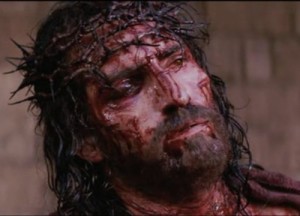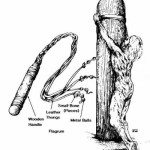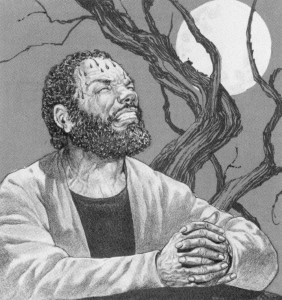Apr
2
On Jesus’ Death, part 2 of 4: Beatings and Flogging
Physical Exhaustion & Trauma
Anguish in the Olive Grove:
To examine the physical exhaustion and trauma that Jesus experienced during His final hours, we must begin in Gethsemane. It was there that He knelt in fervent prayer, knowing that His imminent suffering and death were fast approaching. The Bible says that He was distressed and troubled, telling His disciples, “My soul is overwhelmed with sorrow to the point of death.” (Matt. 26:38 and Mark 14:34) In fact, Luke says that He was in such anguish that His sweat “was like drops of blood falling to the ground.” (Luke 22:44)
Note that it does not say that he was sweating actual drops of blood, but instead uses a simile. Now, this could be a bit of hyperbole used to emphasize the intensity of Jesus’ anguish. Besides, the Gospels tell us that it was already dark, so there would need to be a good amount of moonlight or torchlight for one of the disciples to notice the color of Jesus’ sweat.
But, it is also possible that there was some actual blood mixed in with His sweat. There is a rare medical condition called hematidrosis, which occurs at times of extreme stress. The capillaries in the sweat glands break down, resulting in enough bleeding to cause the sweat to have a pinkish color. Although the amount of blood is not significant, the skin is left very sensitive. It would also be an indicator of the intense distress Jesus’ mind and body were going through even before his arrest.
——–
Sidebar: I would like to bring up one other verse regarding this point which is often left unmentioned. In the same passage in Luke 22, between His submission to the Father’s will (v.22) and the sweat like drops of blood (v.24), it says that an angel appeared and strengthened Jesus. It isn’t clear whether it was a strengthening of His resolve and/or some other type of spiritual, emotional, or physical strengthening. It doesn’t say if the angel spoke or touched Him, so perhaps just seeing the angel was an encouragement that the Father was still with Him. On the other hand, the angel may have conferred some measure of divine, superhuman endurance upon Jesus’ otherwise human body, in order to help Him withstand the torture (and stay conscious) until the appointed time. (There may be theological problems with this hypothesis in regards to when & how much divine power Jesus could access, but it was just a thought.) Or, maybe it was something in between. Regardless, I suppose it may not even be worth mentioning in an apologetics argument. After all, a skeptic is not likely to say, “So what if Jesus went through all that torture?! That angel gave Him extra ‘strength points’! He cheated!” Skeptics don’t typically believe in angels, after all.
——–
The Beatings:
The first recorded instance of physical abuse that Jesus suffered during “the Passion” at the hands of others is when He was brought before Annas immediately after His arrest. When Jesus answered Annas’ question, an official standing nearby thought Jesus was being insolent and struck Him in the face. (John 18:19-24)
The next occasion was during His trial before the high priest Caiaphas and the ruling council of the Sanhedrin. When Jesus finally confirmed that He claimed to be “the Messiah, the Son of God”, the high priest accused Him of blasphemy, and the rest agreed and condemned Him as “worthy of death”. They blindfolded Him, spit in His face, punched and slapped Him (Matt. 26:57-68; Mark 14:53-65). Mark and Luke (Luke 22:63-65) mention that the guards also joined in the beating and mocking.
While there is no specific mention of it in the New Testament, it is possible that they also ripped out some or all of Jesus’ beard, too. It was not uncommon to do so in beatings like this. Some believe that the prophet Isaiah’s reference to this (Isaiah 50:6) was not only something he personally experienced but was a prediction of what Jesus would suffer. If He did have His beard ripped out, it may have happened at this point, or later in the Praetorium, or both.
Although the Jewish leaders officially condemned Jesus under Jewish law, they had no authority under Roman law to put Him to death, so they bound and took Him to the Roman procurator (or governor), Pontius Pilate. Pilate heard the accusations but did not find Jesus worthy of any real crime. When he discovered that Jesus was from Galilee and thus under Herod’s jurisdiction, he sent Jesus to Herod. Herod and his soldiers mocked and ridiculed Jesus, though there is no mention in the Gospels of physical abuse. Then Herod sent Him back to Pilate. (Luke 23:6-12)
 Pilate tried again to point out that Jesus had done nothing deserving of death, but the crowd, as “persuaded” by the Jewish leaders, insisted that He be crucified. Perhaps hoping that it would appease their bloodlust, Pilate decided to first have Jesus flogged. (More on this in a minute.) Such scourging was also a prerequisite to crucifixion under Roman law. And remember, if Jesus had indeed suffered from hematidrosis in Gethsemane, his skin was unusually sensitive, thereby heightening the pain of the beatings and flogging.
Pilate tried again to point out that Jesus had done nothing deserving of death, but the crowd, as “persuaded” by the Jewish leaders, insisted that He be crucified. Perhaps hoping that it would appease their bloodlust, Pilate decided to first have Jesus flogged. (More on this in a minute.) Such scourging was also a prerequisite to crucifixion under Roman law. And remember, if Jesus had indeed suffered from hematidrosis in Gethsemane, his skin was unusually sensitive, thereby heightening the pain of the beatings and flogging.
Sometime after the flogging but before the crucifixion, the governor’s soldiers were able to have a little “fun” with Jesus. They took Him to the Praetorium (i.e., probably the Judgement Hall in the governor’s palace stronghold), stripped Him, put a scarlet/purple robe on Him, forced a crown of long thorns onto His head, and put a staff in His right hand. Then they mockingly bowed and hailed Him as King of the Jews. But, they also spit on Him and struck Him repeatedly about the head and face with the staff. (Matt. 27:27-31; Mark 15:16-20; John 19:1-3) Note that this brutal beating was after the already incredibly agonizing torture of the flogging.
Pilate then had the brutally beaten Jesus brought out (wearing the robe and crown of thorns) and again attempted to get the Jewish leaders to listen to reason. Perhaps he thought the severity of punishment that had already been administered would be deemed sufficient. But, they demanded Jesus’ death, so Pilate reluctantly ordered his soldiers to proceed with the crucifixion. (Matt. 27:1-2,11-26; Mark 15:1-15; John 18:28 – 19:16)
The Flogging (or Scourging):
In the Praetorium, Jesus would have been completely stripped and bound to a whipping post. He would then have been severely flogged about the shoulders, back, buttocks, and backs of the legs. The leather braids would also often wrap around to the fronts of the legs and the chest and abdomen. The soldiers who did the flogging were officially supposed to limit themselves to 39 lashes, but it was common for them to really get “into it” and give many more.
Now, to truly understand the brutality of this practice, one must realize that they did not use a bullwhip or even a typical cat-o’-nine-tails. The whip, or flagrum, consisted not only of several, braided leather strips attached to a short handle, but several shards of broken bone and iron balls were also tied in among the leather strips. Not only did each lashing cause lacerations from the leather, but it also caused the sharp bone shards to slice deeply into the skin and muscle, ripping out chunks of flesh when the flagrum was pulled back. This would often expose ribs, veins, even the spine and some internal organs over the course of the scourging. Also, the metal balls would cause severe bruises that sometimes broke open with later blows, thus adding to the trauma and agony. As one physician put it, the flogged areas would be reduced to “quivering ribbons of bleeding flesh.” As I will describe in a moment, this treatment would put the victim into critical condition, and many died before they even got to the place where they were to be crucified.
 Obviously, these wounds would have caused significant blood loss, perhaps as much as half of Jesus’ total body volume of blood, causing Him to go into hypovolemic (or cardiovascular) shock. When less and less blood is returned to the heart, less and less is pumped out. The resulting drop in blood pressure causes it to beat faster and harder (140-160+ bpm). This is called tachycardia, the first physiological effect of hypovolemic shock. An athlete in good shape (and no loss of blood) only sustains this for a short while, but Jesus experienced this for His remaining hours, which would eventually lead to acute heart failure. It is not surprising that He would have had trouble standing and staying conscious, let alone carrying a cross — even just the horizontal crossbar, which was likely the case.
Obviously, these wounds would have caused significant blood loss, perhaps as much as half of Jesus’ total body volume of blood, causing Him to go into hypovolemic (or cardiovascular) shock. When less and less blood is returned to the heart, less and less is pumped out. The resulting drop in blood pressure causes it to beat faster and harder (140-160+ bpm). This is called tachycardia, the first physiological effect of hypovolemic shock. An athlete in good shape (and no loss of blood) only sustains this for a short while, but Jesus experienced this for His remaining hours, which would eventually lead to acute heart failure. It is not surprising that He would have had trouble standing and staying conscious, let alone carrying a cross — even just the horizontal crossbar, which was likely the case.
Another physiological condition caused by hypovolemic shock is that the kidneys go into overdrive, reabsorbing every drop of fluid filtered through them. This means that there is nothing left from which to make urine. (In itself, this was probably the least of Jesus’ problems.) The reduced blood volume triggers the thirst response in order to try to replace body fluids. As a result, Jesus would also have been extremely thirsty, and He probably had not had anything to drink since supper the previous evening.
—
Stay tuned for Part 3 this Easter Sunday…
















